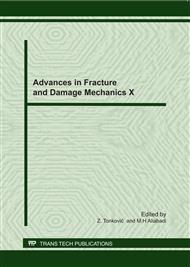p.727
p.731
p.735
p.739
p.743
p.747
p.751
p.755
p.759
Residual Fracture Toughness of Concrete Subject to Elevated Temperatures
Abstract:
This paper presents an experimental investigation on the variation of residual fracture toughness of concrete after being exposed to elevated temperatures. A total of 60 specimens, with a uniform size of 200x200x230mm and precast notches of 80mm in height, were heated to constant temperatures of 65°C, 120°C, 200°C, 300°C, 350°C, 400°C, 450°C, 500°C and 600°C respectively. After cooling, standard wedge splitting tests, according to the corresponding Chinese Specification, were employed. The results indicate that the elevated temperature has significant influence on the residual fracture toughness of concrete. The magnitude of fracture toughness decreases drastically with increasing temperature. Additionally the relationship between residual fracture toughness and weight loss of specimens with respect to temperatures is also investigated.
Info:
Periodical:
Pages:
743-746
Citation:
Online since:
September 2011
Authors:
Keywords:
Price:
Сopyright:
© 2012 Trans Tech Publications Ltd. All Rights Reserved
Share:
Citation:


